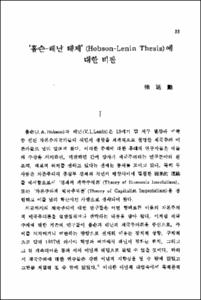1980년대 이후 울산지역의 제조업 변동
- Alternative Title
- Manufacturing Changes in the Ulsan Region since the 1980's
- Abstract
- 이 글은 공간적 분업론, 지역불균등발전론과 관련하여 1980년대 이후 울산지역의 제조업 변동을 살피고 있다. 분석의 결과 울산지역은 중화학공업을 중심으로 한 제조업의 실행기능에 전문화되어 있어서, 공간적 분업론이 더욱 적용가능성이 높다고 볼 수 있다. 또한 1980년대에 걸쳐 제조업 고용은 울산시에서 울주군으로 확장되는 경향을 보이지만 1990년대 들어서는 울산시의 제조업 생산이 다시 활발해지고 있다. 그리고 울산지역 제조업은 전국에 비해 부가가치율이 떨어지는 것으로 나타나, 지역경쟁력을 강화하기 위해서는 제조업의 고부가가치화가 시급하다고 보여진다. 이는 자동차, 선박, 석유화학 등 일부품목에 편중되어 있는 울산지역의 산업구조를 정보통신기술, 친환경적 산업과 관련하여 다양화시키는 것을 의미한다.
This paper is a theoretical examination of manufacturing changes in the Ulsan region since the 1980's, particularly in regard to the theories of spatial division of labor and uneven regional development. Major results of the analysis show that the Ulsan region is specialized in the execution of the heavy-chemical manufacturing industry, which makes the theory of spatial division of labor more applicable. Other meaningful observations of this paper are as follows. While the increase rate of employees who engage in the manufacturing industry of the Ulju county is higher than that of the Ulsan city during the 1980's, we can find the manufacturing productivity of the latter area revitalized since the 1990's. The ratio of the added-value of the manufacturing industry in the Ulsan region is below the national average, which would demand the creation of the higher added-value in the regional industry for the strengthened competitive power. It would also demand the diversification of the industrial structure in that region from the restricted items of automobiles, ships and petrochemicals to the prospective sectors such as the information-communication thechnologies and the eco-friendly industries.
This paper is a theoretical examination of manufacturing changes in the Ulsan region since the 1980's, particularly in regard to the theories of spatial division of labor and uneven regional development. Major results of the analysis show that the Ulsan region is specialized in the execution of the heavy-chemical manufacturing industry, which makes the theory of spatial division of labor more applicable. Other meaningful observations of this paper are as follows. While the increase rate of employees who engage in the manufacturing industry of the Ulju county is higher than that of the Ulsan city during the 1980's, we can find the manufacturing productivity of the latter area revitalized since the 1990's. The ratio of the added-value of the manufacturing industry in the Ulsan region is below the national average, which would demand the creation of the higher added-value in the regional industry for the strengthened competitive power. It would also demand the diversification of the industrial structure in that region from the restricted items of automobiles, ships and petrochemicals to the prospective sectors such as the information-communication thechnologies and the eco-friendly industries.
- Issued Date
- 1996
- Type
- Research Laboratory
- Alternative Author(s)
- Hahn, Sang-Jin
- Publisher
- 사회과학논집
- Language
- kor
- Rights
- 울산대학교 저작물은 저작권에 의해 보호받습니다.
- Citation Volume
- 6
- Citation Number
- 2
- Citation Start Page
- 81
- Citation End Page
- 93
- Appears in Collections:
- Research Laboratory > Journal of social science
- 파일 목록
-
-
Download
 000002025091.pdf
기타 데이터 / 1.27 MB / Adobe PDF
000002025091.pdf
기타 데이터 / 1.27 MB / Adobe PDF
-
Items in Repository are protected by copyright, with all rights reserved, unless otherwise indicated.